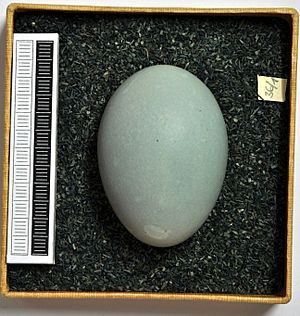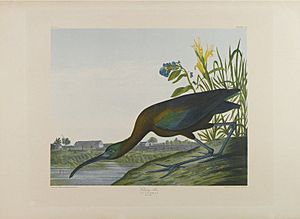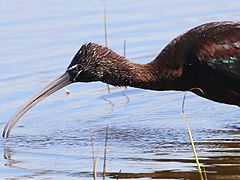Glossy ibis facts for kids
Quick facts for kids Glossy ibis |
|
|---|---|
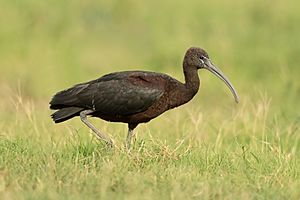 |
|
 |
|
| Conservation status | |
| Scientific classification | |
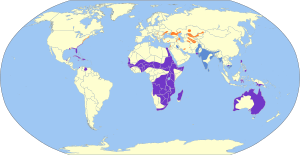 |
|
| Synonyms | |
|
The glossy ibis (Plegadis falcinellus) is a beautiful wading bird. It belongs to the ibis family, called Threskiornithidae. Its scientific name comes from old words. Plegados from Ancient Greece and falcis from Latin both mean "sickle." This name describes the special curved shape of the bird's beak.
Contents
Where Do Glossy Ibises Live?
The glossy ibis is found in many places around the world. You can see them in warm parts of Europe, Asia, Africa, Australia, and the Americas. They are the most widespread type of ibis.
Scientists think these birds first came from the "Old World" (Africa, Europe, Asia). Then, in the 1800s, they naturally spread from Africa to South America. From there, they moved into North America. The first time a glossy ibis was seen in the Americas was in 1817 in New Jersey.
Many glossy ibises are migratory. This means they fly to warmer places for winter. For example, most birds from Europe spend winter in Africa. In North America, birds from the northern parts fly south for the colder months.
How Do Glossy Ibises Behave?
Glossy ibises move around a lot, especially after they have finished breeding. They are very nomadic, meaning they don't stay in one place for long. Birds from colder regions fly long distances to warmer areas. For example, some fly across the huge Sahara Desert.
Ibises that breed near the Black Sea often spend winter in West Africa. Those from the Caspian Sea might go to East Africa, the Middle East, or even as far as India. In India, the number of glossy ibises changes a lot with the seasons. This suggests they move to find the best places to breed.
When it's not breeding season, you might see large groups of over 100 ibises flying together. They often look for food in smaller groups. At night, glossy ibises like to roost (rest) together in big flocks. They sometimes join other bird species in trees, which can be far from their feeding spots.
What Kind of Habitat Do They Like?
Glossy ibises like to feed in very shallow water. They build their nests in wetlands, which are areas of land covered by water. These wetlands can be freshwater or slightly salty (brackish). They prefer places with tall, thick plants like reeds or papyrus, and low trees or bushes.
You can often find them near the edges of lakes and rivers. But they also live in lagoons, wet meadows, swamps, and even flooded farmlands. They are not as common in coastal areas like estuaries or salt marshes. For sleeping, they usually choose large trees, which might be a bit away from where they eat.
Reproduction and Life Cycle
Glossy ibises build their nests from twigs and plants. The nest is usually at least 1 meter (about 3 feet) above the water. Sometimes, it can be as high as 7 meters (about 23 feet) in tall plants or bushes.
A female ibis usually lays 3 to 4 eggs, but sometimes up to 5. Both the male and female birds take turns sitting on the eggs. This incubation period lasts for about 20 to 23 days.
The young birds can leave the nest when they are about 7 days old. However, their parents continue to feed them for another 6 or 7 weeks. The young birds are ready to fly (fledge) when they are around 28 days old.
What Do Glossy Ibises Eat?
The diet of the glossy ibis changes depending on the season and what food is available. They eat many different things!
Their prey includes:
- Insects: Like water beetles, dragonflyes, damselflyes, grasshoppers, crickets, flyes, and caddisflyes.
- Worms: Including leeches.
- Molluscs: Such as snails and mussels.
- Crustaceans: Like crabs and crayfish.
- Sometimes, they also eat small fish, amphibians, lizards, tiny snakes, and even baby birds from other nests.
What Do Glossy Ibises Look Like?
The glossy ibis is a medium-sized bird. It is about 48 to 66 centimeters (19 to 26 inches) long. Its wingspan, which is the distance from wingtip to wingtip, is about 80 to 105 centimeters (31 to 41 inches). These birds usually weigh between 485 to 970 grams (about 1 to 2 pounds).
Adult ibises that are ready to breed have reddish-brown bodies. Their wings are a shiny bottle-green color. Younger birds and those not breeding have duller colors. They have a brownish beak and dark skin on their face. This skin is bordered by blue-gray, which turns bright cobalt blue when they are breeding. Their legs are reddish-brown.
Unlike herons, which fly with their necks pulled back, ibises fly with their necks stretched out. Their flight is very graceful, and they often fly in a V formation.
Glossy ibises are usually quiet birds. But they do make different croaking and grunting sounds. When they are breeding, they might make a hoarse "grrrr" sound.
Conservation Efforts
The glossy ibis is protected by an agreement called the Agreement on the Conservation of African-Eurasian Migratory Waterbirds (AEWA). This agreement helps protect birds that migrate across Africa and Eurasia.
Glossy ibises can face threats to their homes. Their wetland habitats can be damaged or lost due to things like drainage, too much salt in the water, or new plants taking over.
Images for kids
See also
 In Spanish: Morito común para niños
In Spanish: Morito común para niños



